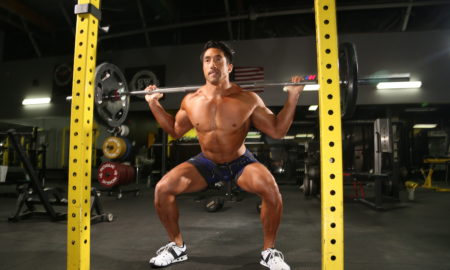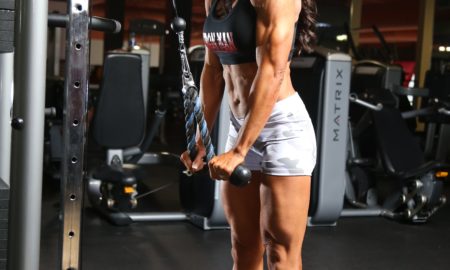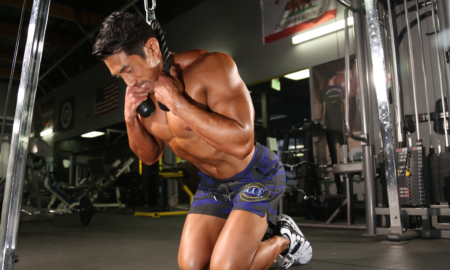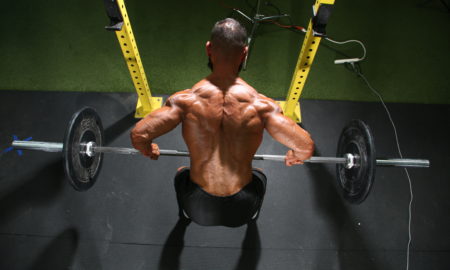Q: I’m 47 years old, and I’ve found myself being injured more and more. I have bad knees, both of my shoulders ache after I bench-press, and one elbow has what the personal trainer calls tennis elbow. I train pretty heavy, with mostly free weights. Do you have any suggestions for how I can limit injuries as I age but continue to train moderately heavy?
A: I think the key to training longevity and making gains is knowing your body’s musculoskeletal system and exactly which exercises are biomechanically perfect for each bodypart. For instance, you say that you use “mostly free weights.” Why? Is it a matter of limited equipment? Or did you read somewhere that you can build big muscles only with free weights? Free weights aren’t the only way to build muscle—at least not for everyone—and it’s not so smart as you age to rely on free weights only. I believe in finding your most leverage-advantageous exercise for each bodypart and sticking with it.
Let’s start with your knee pain. I bet you’re one of those guys who believe that your thighs won’t grow unless you grind your femur into your kneecap with heavy squats. As I’ve said on numerous occasions, squatting fits some but not all people who train with weights. You can build great thighs with leg presses and hack squats—and leg extensions and leg curls done after the multijoint movements.
What about your shoulder problem? Have you been bench-pressing for 30 years? I assume the answer is yes. How wide are your clavicles? How long are your arms? How much pectoral muscle do you have to work with? Some men are simply not built for bench-pressing and should do dumbbell declines, machine presses and perfected-form cable exercises or pec deck flyes. Those who need help with chest development see the guy with huge pecs bombing away on bench presses every other day and think that it has to be the way to huge pectorals—right? Wrong. While it has worked for many, heavy free-weight bench-pressing can cause severe long-term injuries.
If you have very long arms and narrow clavicles, you’re probably going to get very little out of heavy free-weight bench presses besides rotator cuff injuries—or serious nerve-pinching immobility. I’m not saying that’s going to happen to all, or even most, people; however, it can happen to anyone who’s built like that. Dumbbell decline presses often are a much better choice.
Long-armed people usually have, at minimum, a great grip and forearms and, at best, great arms all around. Doing just three moderately heavy preacher curls and one 25-rep barbell wrist curl set before decline dumbbells presses can give you a 10 to 20 percent advantage. That adds extra thickness to the two places that touch during the hardest phase of any pressing movement. Now do another set of preacher curls and wrist curls and start heavy machine vertical bench presses and see how that feels.
When you do flat-bench or even incline barbell presses, you have a psychological block. For years you’ve struggled with them, and you’ve failed so many times that your mind won’t let you relax enough to go up in weight. Any professional in any sport should make that sport look easy. You should be cranking out those reps as if you had pistons in your arms; if you’re not, you’re doing the wrong exercise.
With the machine vertical bench press the fear is gone. You do some really smooth decline dumbbell presses, and you slide over to the vertical bench machine and load the weight on. Watch how your rhythm changes—from awkward and heart-thumping uselessness and embarrassment on the flat bench to smooth, crisp sets of 10 to 12 without stopping. You resemble Tiger Woods driving a 360-yard tee shot straight down the fairway. What changed? You didn’t. The weights didn’t. The exercises and how you approached them mentally did.
Lastly, your tennis elbow. Three sets of wrist curls and reverse wrist curls for the ulna and radial heads three times a week should help. Do both with a barbell, and use very short strokes and high reps. With forearms on your knees and your hands at the edges of your knees, move the bar in toward the bellies of your forearms and let your hands roll back so that they’re just even with your forearms. Do as many reps as you can while squeezing both hands on the bar. For the outer heads, do the same thing, but your hands should be nearly pronated. Bring them up as high as you can, squeezing the bar and the outer heads of the forearms. When you’re done training them, ice both the inside and outside forearms. (If you can, ice both for two 20-minute periods after training them—with at least 20 minutes between icings).
Change your strategy from a “this worked for Arnold so it will work for me” approach to a “this seems to work for me just right, and the movements are biomechanically perfect for me” mind-set, and you have the rest of your life to enjoy training and the fruits of that labor—more muscle, more power and no injuries! IM
Editor’s note: Contact Paul Burke via e-mail at [email protected]. Burke has a master’s degree in integrated studies from Cambridge College in Cambridge, Massachusetts. He’s been a champion bodybuilder and arm wrestler, and he’s considered a leader in the field of over-40 fitness training. You can purchase his book, Burke’s Law—a New Fitness Paradigm for the Mature Male, from Home Gym Warehouse. Call (800) 447-0008, or visit www.Home-Gym.com. His “Burke’s Law” training DVD is also now available.




















You must be logged in to post a comment Login